Autumn 2017
| From the Editor
Lent is one of the seasons of Easter “From a Small Seed a Mighty Trunk May Grow” Bethlehem University – An Oasis of Peace in the Holy Land A new way to appreciate Handel’s Messiah |
From the Editor “Autumn is a time of harvest, of gathering together. For nature, it is a time of sowing, of scattering abroad.” Considering the diversity of this newsletter he had it right for our congregation as we’re busy with the now, but sowing the seeds of massive change. One change is that our valued producer, Rod Mummery, has also been persuaded to write the Church Council Report which alludes to a number of items in this, another packed newsletter. Thanks to Rod and all those who gave their time and words to make it so. Read it at your leisure! Suzanne Yanko Lent is one of the seasons of Easter Lent, with its attentive turn to Christ’s way to the cross, is upon us again. As you’ve probably heard me say several times before, Lent is, with all the church seasons, one of the seasons of Easter – as much a season of the Easter it follows as the one it anticipates. As such, it presents the same opportunity as does every liturgical season to consider who Jesus the crucified and risen one is and who we are in him. Each season, however, sings in the Easter song in its own peculiar key. Perhaps the key for Lent is minor, with more than a little discordance. Our part is to hear the song, to resonate with its strains and to feel the clashes in the death and the life which Lent relates – first Christ’s, then ours.
“In a time of favour I answer you, on the day of salvation I help you.” (Isaiah 49.8) After quoting this, the apostle Paul continues with the words: “Now is the acceptable time! Now is the day of salvation!” (2 Corinthians 6.2). I, in turn, call upon you to witness that now the days of redemption have come, now has come, in a sense, the moment of spiritual healing. We can take care of all of the stains from our vices, all the wounds from our sins, if we pray constantly to the doctor of our souls, if …we do not neglect any of his prescriptions… The doctor is our Lord Jesus who said: “It is I who bring forth both death and life” (Deuteronomy 32.39). The Lord first brings forth death and then he gives back life. Through baptism, he destroys in us adulteries, homicides, murders and theft; then he brings us back to life as new persons in eternal immortality. We die to our sins, of course, through baptism, we return to life in the Spirit of life… Let us surrender to our doctor with patience in order to regain health. Everything that he will have detected in us that is unworthy, soiled through sin, eaten by ulcers, he will trim, he will cut it, he will take it away, so that once all the wounds inflicted by the demon have been eliminated, only what belongs to God will remain. This is his first prescription: to consecrate forty days to fasting, to prayer, to vigils. Fasting heals flabbiness, prayer nourishes the reverent soul, vigils reject the devil’s traps. After this period of time given to all these observances, the soul that is purified and exhausted from so many practices, comes to baptism. It regains strength by plunging into the waters of the Spirit: everything that had been burnt in the flames of illness is born again in the dew of heaven’s grace… By means of a new birth, we are born again changed.” They knew how to say it in those days! Yet, however it is said, the dying and the rising – Christ’s, and ours – is the heart of the matter. News from Church Council Again, matters around the Mark the Evangelist Futures Project have comprised the larger part of Church Council business in recent months. After the congregational meeting of 4 December Church Council, noting the preference of the Congregation at its meeting of 4 December, resolved to express its preference for proceeding under Option 5.a+. At its meeting last week (2 March) the final version of the Business Case was approved. The Business Case will now go to Yarra Yarra Presbytery for approval, then to several Synod bodies before being considered by the Synod Property Board on 19 April for final approval. Other matters considered by the Council include:
(Comments, suggestions and queries are welcomed by the Church Councillors: Gaye Champion, Michael Champion, Belinda Hopper (Secretary), Gus MacAulay, Rod Mummery(Treasurer), Tim O’Connor (Chair), Maureen Postma, Craig Thompson (Minister) and Alan Wilkinson (Presbytery appointee).) The Commonality of Churches For where two or three are gathered in my name, there am I among you. (Matthew 18:20) We have just returned to Australia after living in West Lafayette, Indiana in the USA for the past nine years. Whilst there, we were members of the First United Methodist Church (FUMC) in West Lafayette (www.fumcwl.org). Previous to living in the US, we attended the Indooroopilly Uniting Church (www.indooroopillyuc.org.au) in Brisbane where we first met Mary and David Sutherland. We began attending MtE in September, 2016. We thought we would share some of what we experienced at FUMC, in the heartland of the US, where regular church attendance is still a normal way of life, although that is changing. FUMC has a substantial congregation of around 500 members and offers four service times on a Sunday, the 8.30am, 11.am, both traditional services and two contemporary services called “WIRED”. The Church had moved from being right in the middle of the campus of Purdue University in 2005 to a site on acreage further out of town, and had built a multi-purpose building able to accommodate the various activities that were offered. Between the 8.30am and 11am services, they hold Adult Sunday School classes as well as classes for children and the youth. Year round there is a large variety of topics and types of classes, each running for a term, so there is something for everyone. These classes were an excellent place to explore matters of faith amongst fellow sojourners and a great activity by which to really get to know others in the congregation. There is also a strong emphasis on missions, such as donating food to the various Food Pantries and to at-risk children in the various elementary schools in the area. At First United, we didn’t have a traditional sanctuary, but used a space which had been designed to be used as a gymnasium once the real church sanctuary was built, sometime in the future. During our time at FUMC there were serious, sometime contentious, discussions on building a new sanctuary, then the global monetary crises came along and the parishioners were reluctant to go ahead. This process reminded us of Indooroopilly UC’s deliberations to renovate their sanctuary and surrounding rooms during the time we were members there, as well as the recent deliberations of the MtE congregation regarding the decisions about property following the calamity with the church steeple. Looking back at being members of the above Churches over the past 20 years, we realize that all of these places have a commonality, despite the differences in their size and location, and, for that matter, even the country they were in. First and foremost, they have had a welcoming atmosphere. In all of these places we have felt the outpouring of love and acceptance. Secondly, all three Churches have been associated with nearby universities or places of learning which greatly enhances the congregation as a whole. And third, all of the Churches have had a number of retired ministers who are part of the congregation and who are more than willing to lead worship themselves, when in need – a true fountain of knowledge and experience at our fingertips. We are feeling very blessed in being accepted as members of the congregation of MtE and look forward to continuing our spiritual journey with you. David and Vicki Radcliffe live in North Melbourne and have two children, Dylan (with grandson, Eric) who lives in Melbourne and Sarah who lives in London. “From a Small Seed a Mighty Trunk May Grow” (Article in the January edition of Hotham Herald)
It’s a common folly that some people assume that being small equates with insignificance or inefficacy, that somehow because of a particular entity’s restricted stature it is incapable of real impact. Or reflect instead on the amazing Rufous hummingbird – one of the world’s smallest birds which grows up to a mere 8cm in length and weighs about 2.5 grams. Despite its diminutive size, it can fly at speeds of up to 54km/h and travels an extraordinary distance of 6200 km for its annual migration from Alaska to Mexico, making it one of the furthest travelling migratory birds in the world. A tiny bird only 8cm long, weighing less than a 20 cent piece, travelling a 12000 km round-trip … every year. And then there’s the Penicilium fungi – the microscopic sporous powder-like fungi that grows in moist soils and rotting organic matter and was considered little more than a pesky mould that spoilt one’s fruit and vegetables – that was until Scottish Scientist, Sir Alexander Fleming, discovered its antibiotic properties in 1928 and began the process of manufacturing the drug penicillin for the treatment of infections. That tiny green and white mould found inhabiting the bottom of the domestic fruit bowl was one of the greatest medical discoveries of all time and continues to be credited with saving millions of lives worldwide, every single year. Here are three examples of very small life forms capable of remarkable things, each with unique and truly significant abilities. And it is among this class of small and yet invaluable wee things that Hotham Mission can be counted. Hotham Mission – whose history is rooted in the benevolent institution of the former Methodist Mission based on top of Hotham Hill (now known as North Melbourne), began its journey supporting down-and-out mothers and impoverished children suffering the throes of life in the Depression-era urban slums. Today, it remains true to its heritage and is comprised of a small, single-digit team of dedicated individuals committed to creating positive change, tangible impact and real opportunities for some of Melbourne’s most disadvantaged, marginalised and vulnerable young people and their families. Driving this small team is a powerful engine of volunteers, generous benefactors, committed congregations, an enthusiastic governing Board and a strategic and passionate sense of equality and empowerment for those with whom we work. And the seeds which have been sewn by this committed tiny crew are reaping a rich harvest. In 2015, Hotham Mission supported some 200 young people and their families across a broad range of programs and partnerships with other agencies. These included the various holiday programs, homework clubs, early intervention and prevention programs, food security initiatives, asylum seeker accommodation and advocacy support, and programs delivered by other services providers supported by Hotham Mission. As we expanded our reach to touch more local agencies, schools and youth-focussed organisations, we refined our approach and honed our operations to ensure greater access to resources, improved delivery of programs, and dedicated ourselves to providing relevant and effective supports to those who needed it most. In 2016, this renewed approach saw an expansion in the level of impact that our little Mission has had on the local community. The number of young people and their families, to whom we provided support and opportunity, has doubled to nearly 500 young people and their families. The Food for Thought nutritional support program jumped from 15 fresh food parcels delivered to schools and service providers each week to 70, feeding on average 250-300 people a week. Many of these young people come from migrant backgrounds, some are young mums, others are unaccompanied minors, and all are experiencing food insecurity. The Hotham Mission subsidised lunch voucher system, which operates out of local high schools, saw the number of vouchers issued in 2016 rise from 344 to 492. That’s nearly 500 hungry high school students who would otherwise be without adequate access to healthy food each week. Close to 50 students received support through the Renshaw Education Support program which helps to purchase text books and materials for young people who are continuing their education, and 20 kids received transitional support through our homework club and Mess Club programs. Our partnerships with vital local organisations such as the Kensington Adventure Playground (otherwise known as the Venny), Kensington Neighbourhood House and the Somali Women’s Development Agency, and Lentara’s Asylum Seeker Project, has reached innumerable vulnerable and marginalised young people and their families, including asylum seekers, refugees and socially disadvantaged migrant families. Furthermore, Hotham Mission’s newly instituted Social Research Unit continues to carry out exciting research into the impact, incidence and prevalence of food insecurity amongst youth in the city’s inner North West. We racked up more volunteer hours than ever before – 12,000 collective hours – and have expanded our funding base to include support from the City of Melbourne, RACV, the Cato Trust, the Jack Brockhoff Foundation, the UnitingCare Share Appeal, and generous donations from Glen Waverly Uniting Church, Ivanhoe Grammar School and many others. In 2017, Hotham Mission is dedicated to continuing the valuable work we do in our local community. We are not a large organisation and we have no fancy trappings, no shiny new buildings, no elaborate conference rooms, comfy couches or expensive coffee machines. We do not have the luxury of a massive marketing team and commercial resources, however we are blessed with a wonderfully dedicated group of volunteers and part time staff with genuine passion to move our mountains. Our currency is one of opportunity – working with young people and their families to give them the best chance possible to self-actualise, to recognise their potential and to fulfil it without the added stress of chronic food insecurity, lack of social supports and financial constraints. In 2017, the small Mission which sits atop the old Hotham Hill will continue to do its invaluable work, always supported by the volunteers who will always be integral to our success. We are small, but we are agile, we are responsive, we are creative, and above all else, we are capable of great things, all of which add up to a community impact which is truly, no small feat. As the 19th century poet and author George Eliot stated, “Great things are not done by impulse, but by a series of small things brought together.” Bethlehem University – an Oasis of Peace in the Holy Land (A report on the address* by Brother Peter Bray at the Elm Street Hall, North Melbourne, on Monday 20 February 2017).
In speaking of the role of the University, Brother Peter contextualised the situation of the Palestinians through an area map illustrating the fact that some 10% of the land that was Palestine remains in Palestinian hands. Brother Peter’s talk was interspersed with video clips of several students speaking about their experiences, their hopes, their fears, their yearning to live life to the full.
Checkpoints or barriers may be closed arbitrarily, without notice, requiring detours that may be arduous. A student who comes from Jerusalem to Bethlehem, for example, can never predict how long the bus journey may take, for once the bus arrives at the checkpoint the occupants may be subjected to a cursory check, they may be required to leave the bus and stand for long intervals in the hot sun while their papers are checked, they may be subjected to a strip-search. The system is arbitrary, the student can never know what is going to happen. Fear and uncertainty is with them each day. Yet students display courage and resilience in confronting their anxieties and fears. It is important to note that resistance is not terrorism. It is important to resist. It takes courage and persistence. Brother Peter told of one student who was challenged by the soldiers at a checkpoint and she just shrugged her shoulders and kept walking and passed through the checkpoint. She was determined to get to her exam. on time! Brother Peter observed that fear leads to negativity and that the first duty is to be equal to a situation. An Oasis of Peace
Prophetic Role of the Church A constant watchword for the staff and administrators at Bethlehem University is: ‘is there a better way’? Brother Peter quoted the words of the Patriarch Michel Sabbah, “resist any temptation to fear and despair”, while acknowledging that there is cause to be afraid, that fear must be confronted by reason. The audience was reminded that the first victims of Islamic extremism are Muslims, and that Christians and Muslims must stand together. In balancing the religious affiliations of its student body, the University can pursue its aim to build relationships between the two faith groups, and to encourage the development of open minds. In a graphic of the separation wall shown by Brother Peter, the graffiti of, ‘Bridges not walls!’ seemed to this writer to illustrate something of the work of Bethlehem University. Bethlehem University seeks also to preserve the Palestinian culture and while opportunities for extracurricular activities are limited, it offers traditional dance events, for example. Through his presentation, Brother Peter described the prophetic role of the church that Bethlehem University seeks to fulfil, without allowing fear to paralyse its mission. It has no political power or influence, except for the spoken word. As followers of Jesus, faith is enacted through words and thus no-one can be called the enemy, hate cannot be harboured. Through its institutions – schools, hospitals, clinics – all are welcome. The Christian presence is made visible through words and institutions, and its faith can be the antidote to fear. Responding to the question, “Is there a hope for change in Palestine?” Brother Peter holds out little hope at the moment; but then he said, “Look at what happened in South Africa, Northern Ireland, the fall of communism in East Germany, and East Timor.” How to Connect with & Support the work of Bethlehem University
If you would like to receive the email newsletter News from Bethlehem University, complete the form at www.bethlehem.edu/page.aspx?pid=992 If you would like to support working towards peace and justice in Palestine/ Israel, consider joining
* Address to a public gathering presented by the Uniting Church in Australia, Congregation of Mark the Evangelist, North Melbourne, in collaboration with the Palestine/ Israel Ecumenical Network Inc. (PIEN). Film Group – Enjoying time together I was asked by the Editor to write an update on the (informal) film group. I can hardly remember when I was handed over the role as the co-ordinator of the film group, which meets monthly for over 10 years. Throughout the years, the way of operating remains unchanged – a movie in the morning of the first Friday of the month at the Kino Cinema in the city, and coffee/light lunch at the adjacent food court afterwards. I would choose a movie (suggestions are welcome) and then inform the regular goers by e-mail/phone the day before (i.e. Thursday) about the arrangement. Others who would like to join can always telephone me to find out the information. We seldom have breaks, the activity goes all year round, except during times when I was away or for reasons of extreme weather forecast. The group is not strictly restricted to church members, their friends are welcome. Bev’s friend, Ros, has been with us for years and we enjoy very much her company and her funny travel tales. At the moment, we have 5-6 regular participants. It is enjoyable going to movies together and spending time talking to each other in a relaxed environment. As the co-ordinator, I have the privilege of choosing a movie, but at times it could be difficult when there were no “suitable” movies around. In those circumstances, I would just make the choice to the best of my judgment, knowing that even the movie is not that appealing, the group would always laugh it off and could still have a good chat on the movie. The year 2017 appears to have a good start, with two good movies in a row – “Uniting Kingdom” in January and “Lion” in February. Both are true stories. The former is about the true-life romance between Botswanan King Seretse Khana and his British wife Ruth, who had to face obstacles of racism in the 1940s. The latter is about the story of Saroo, who was adopted by an Australian couple from an orphanage in India and grew up in Hobart, and about his quest to find his lost family in India with just a small store of memories and the help of some newly-developed satellite-imaging technology. As for the future of the film group, I would assume business is as usual as long as there is the demand. A new way to hear Messiah, thanks to the Australian Brandenburg Orch and Choir My opinion: www.classicmelbourne.com.au/reviews/handels-messiah And now the centrepiece of the newsletter: Mark the Evangelist Property Business Case Overview The Business Case for the Mark the Evangelist Futures Project is expected to be completed in March and April for submission to the various councils of the Church for approval. This overview provides a preview of the very large Report (currently 452 pages including appendices) which will be presented at that time for consideration. In summary, the reasons for this project are:
The critical success factors of this business case are:
Financially, Property Option 5.a+ results in net sale proceeds ($7.9m) which will allow for:
The implementation of this property option will be effected by:
1.1 Options Explored 1.2 Heritage and Planning Advice
1.4 Mark the Evangelist (MtE) Mission Objectives
At the outset of the feasibility study, each mission objective was elaborated and the associated property objective was spelt out. The space requirements to meet those property objectives were then identified. This report includes an assessment of how each option satisfies MtE’s Mission Objectives. 1.5 Financial Feasibility of Each Option 1.6 Operational Cash Flow Analysis 1.7 Site Development Program 1.8 Overall Feasibility Assessment 1.9 Conclusion – the Five Property Options for Consideration
1.11 Risk Analysis
1.12 Summary Proceeds for MtE – Property Option 5.a+ High Level Financial Analysis (amounts rounded to $ 000s)
The BOMAR contribution for wider church sharing was calculated on the basis of the decision of the BOMAR Board on 20 September 2016. The Board acknowledged Mark the Evangelist’s missional support for its integrated agency UnitingCare Hotham Mission. Accordingly BOMAR supported an exemption to the Property Sale Proceeds policy for Mark the Evangelist to provide a source of income for the continuation of the current UnitingCare Hotham Mission allocation level. The request to BOMAR which will be presented with the final full Business Case will relate to the one policy variation requested, the final figures for the current UCHM expenditure, and the resulting contribution to the wider work of the church. 1.13 Proposed Cash Flow Projection – Property Option 5.a+
Noticeboard Lenten Studies: Four Studies on the Lord’s Prayer (text by Bruce Barber) 26 March Congregational Picnic following worship (Australian Native Gardens, Parkville) Easter Services: Palm Sunday 9 April 10AM Maundy Thursday 13 April 7:30PM (including the Eucharist and the foot-washing ritual) Good Friday 14 April 10AM Easter Vigil 15 April 8PM Easter Day 16 April 10AM (including the Eucharist and a re-affirmation of baptism) 30 April MtE 2017 AGM 23 April MtE luncheon following worship |

 The fifth century bishop, Saint Maximus of Turin writes of “the forty days that lead us to baptism into the death and resurrection of Christ”:
The fifth century bishop, Saint Maximus of Turin writes of “the forty days that lead us to baptism into the death and resurrection of Christ”: There is a certain beauty in small things. Small can be agile. It can be flexible. As a rule, small creatures generally require less energy to move and function effectively than other big and cumbersome entities. Small can be intricate and detailed, and it can also be exquisite in its simplicity. And small can also possess tremendous power.
There is a certain beauty in small things. Small can be agile. It can be flexible. As a rule, small creatures generally require less energy to move and function effectively than other big and cumbersome entities. Small can be intricate and detailed, and it can also be exquisite in its simplicity. And small can also possess tremendous power. Brother Peter acknowledged the capacity crowd, and explained that such gatherings and opportunities to speak matter immensely, enabling him to return to Bethlehem University and tell people that they are not forgotten by the outside world, that there are people overseas who care and are interested in their welfare and their world. It helps to keep their hopes alive, and to know that as Palestinians they are not automatically equated with terrorism. Visitors are very important because visits gives students and staff a sense of solidarity with the outside world.
Brother Peter acknowledged the capacity crowd, and explained that such gatherings and opportunities to speak matter immensely, enabling him to return to Bethlehem University and tell people that they are not forgotten by the outside world, that there are people overseas who care and are interested in their welfare and their world. It helps to keep their hopes alive, and to know that as Palestinians they are not automatically equated with terrorism. Visitors are very important because visits gives students and staff a sense of solidarity with the outside world.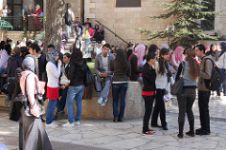 Restrictions for Students
Restrictions for Students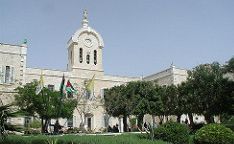 The University is a joint venture between the Vatican and the De La Salle teaching order and was established at Bethlehem in 1973. It has 16,000 graduates and has 3200 students currently. More than 70% of the students are female. Some 73% of the students are Muslim and while less than 2% of the people of Israel/ Palestine are now Christians, Bethlehem ensures that around one-third of its students are Christian in order to build understanding and a sense of community but without proselytising. Israeli regulations prevent Jewish students from attending Bethlehem University.
The University is a joint venture between the Vatican and the De La Salle teaching order and was established at Bethlehem in 1973. It has 16,000 graduates and has 3200 students currently. More than 70% of the students are female. Some 73% of the students are Muslim and while less than 2% of the people of Israel/ Palestine are now Christians, Bethlehem ensures that around one-third of its students are Christian in order to build understanding and a sense of community but without proselytising. Israeli regulations prevent Jewish students from attending Bethlehem University.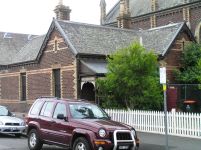 1.3 Building Concepts and Key Assumptions
1.3 Building Concepts and Key Assumptions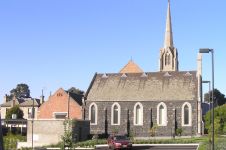 1.10 Recommendation – Property Option 5.a+ Preferred
1.10 Recommendation – Property Option 5.a+ Preferred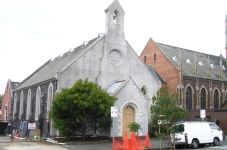 1.14 Next Steps
1.14 Next Steps